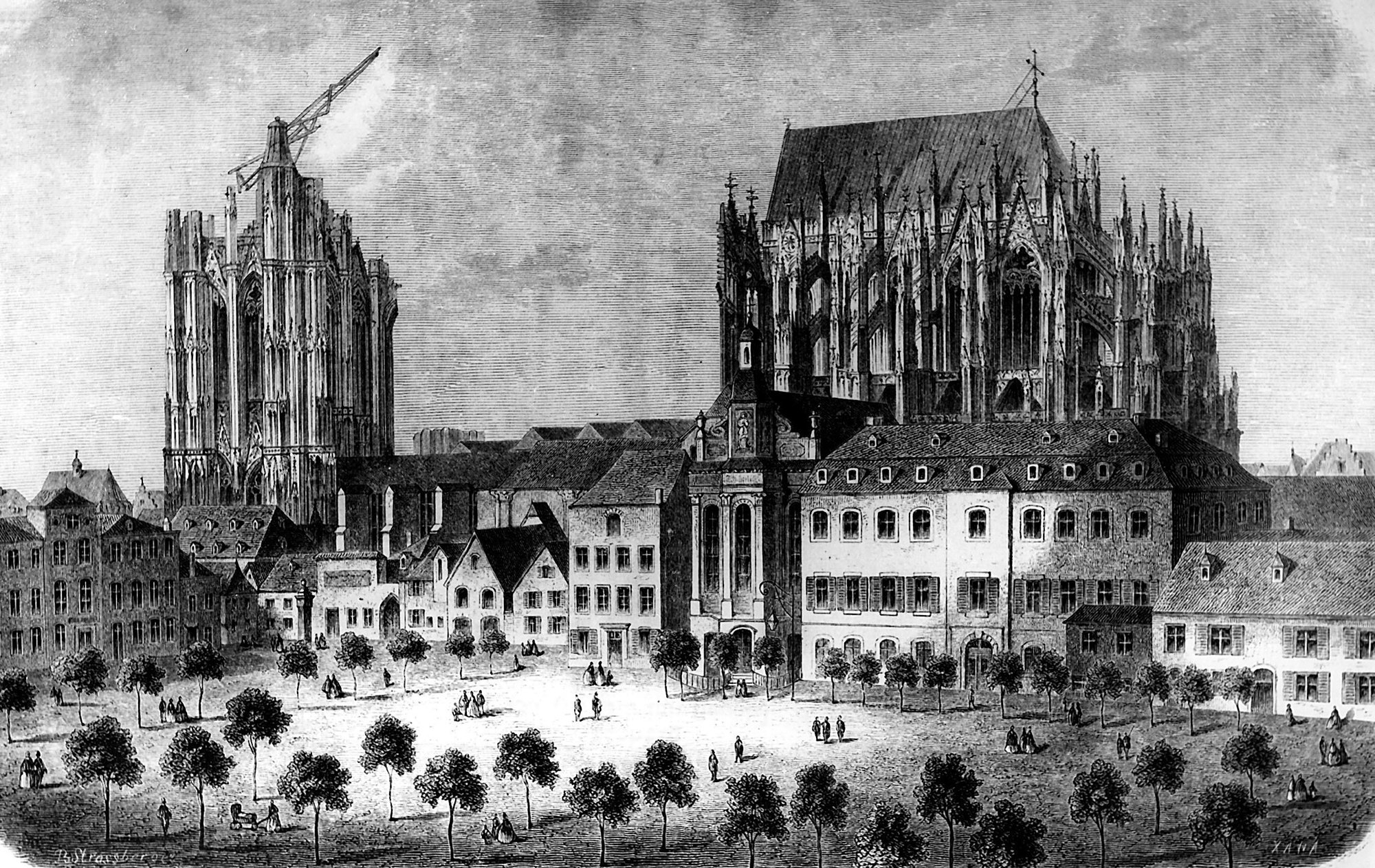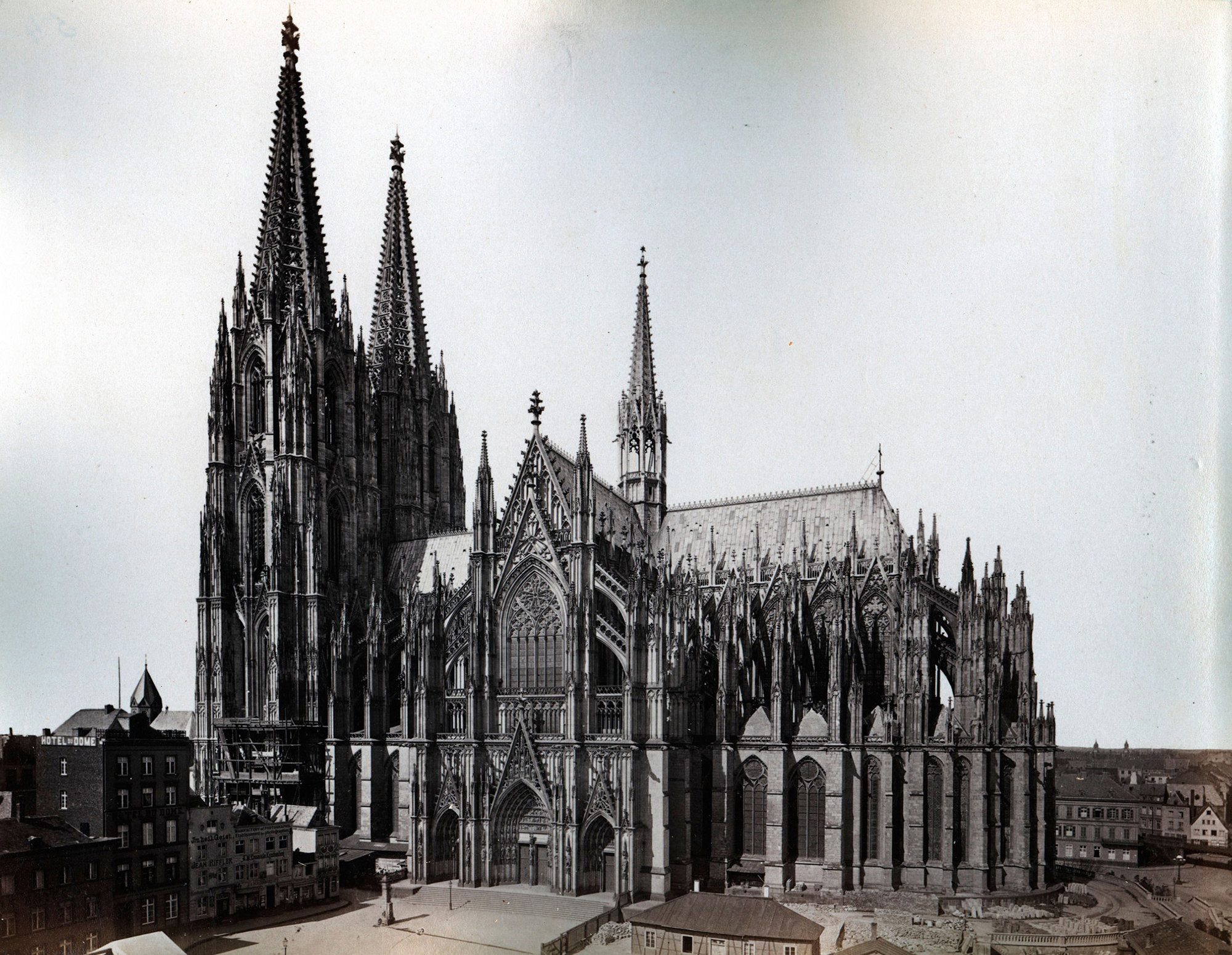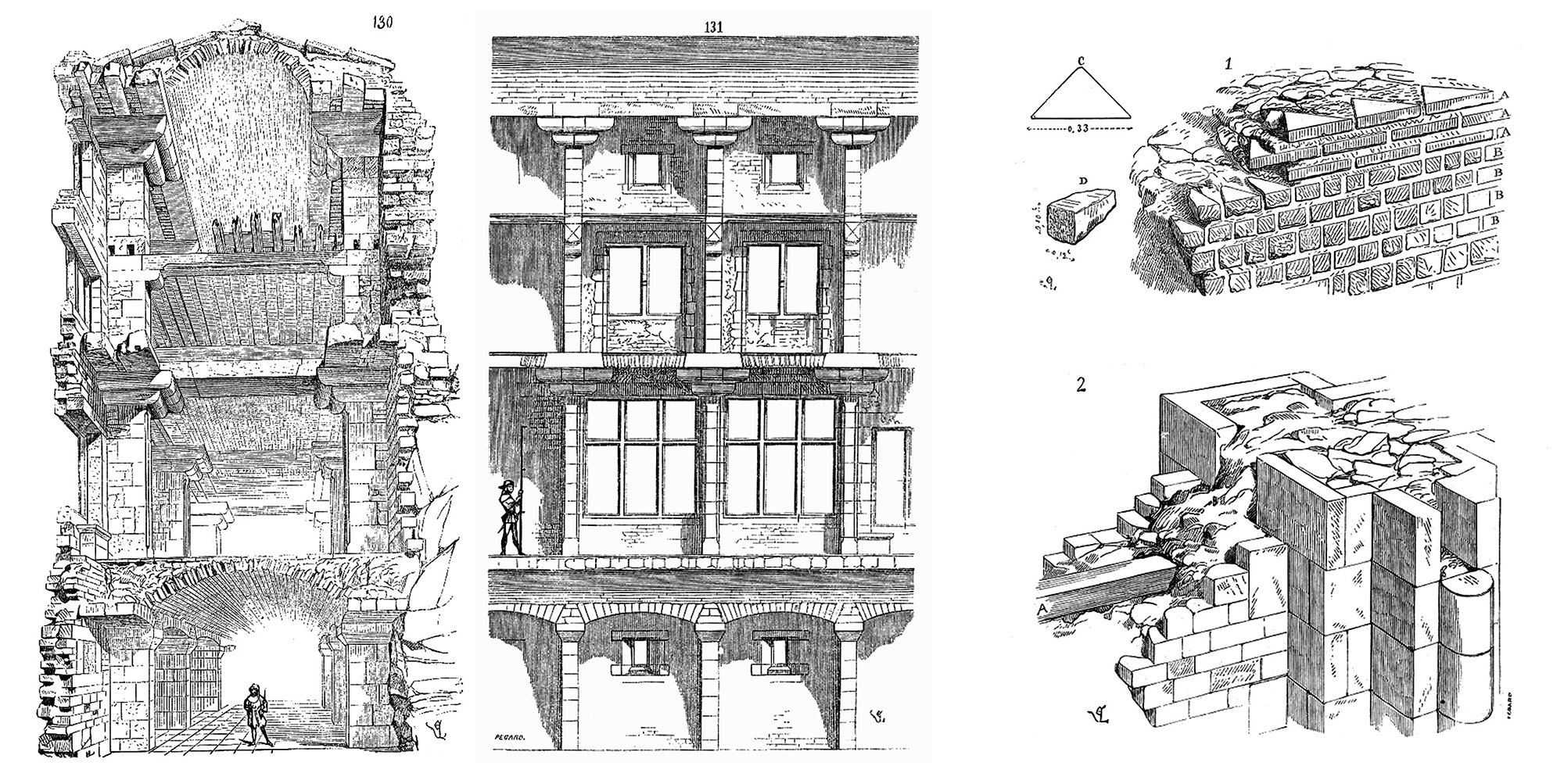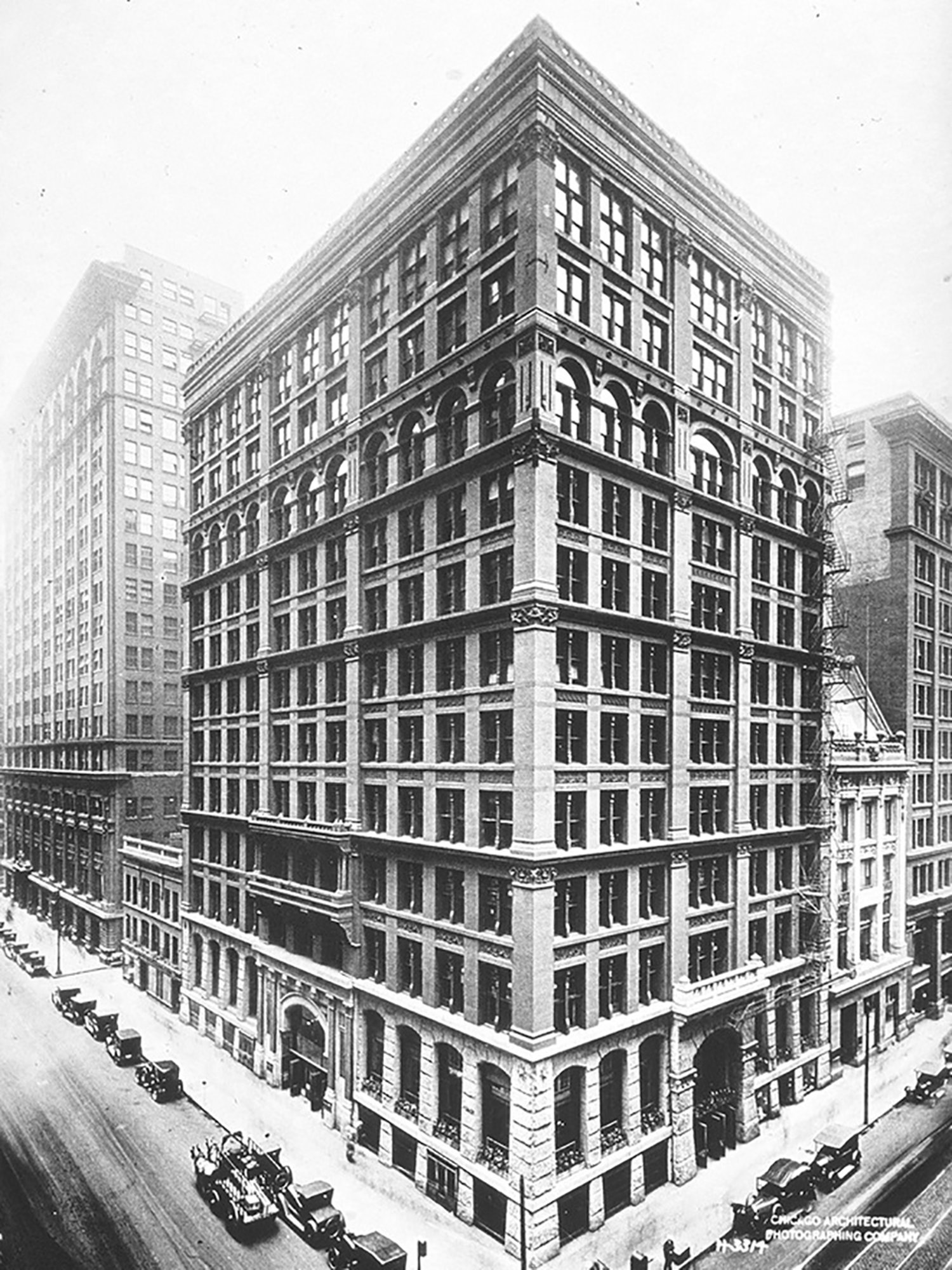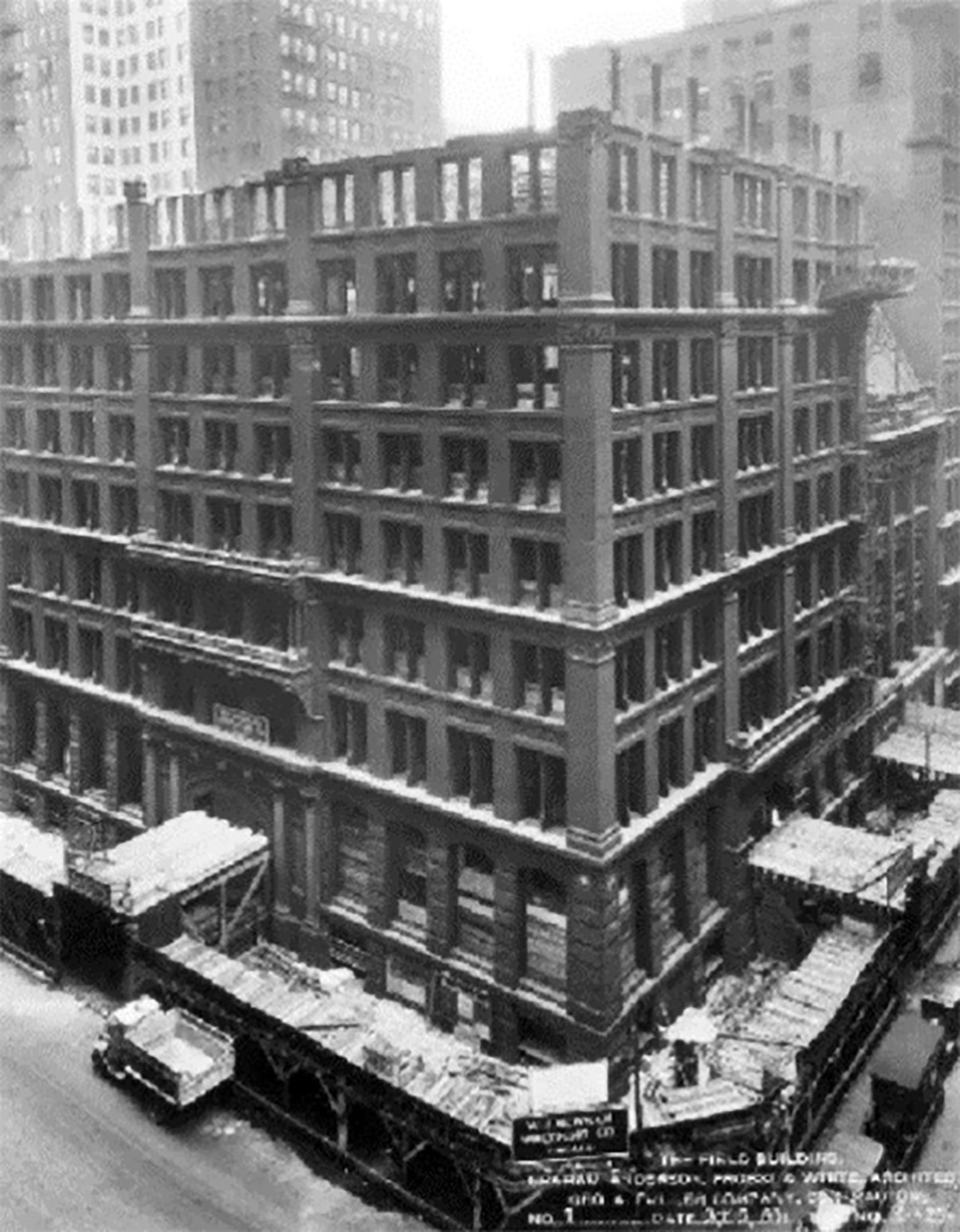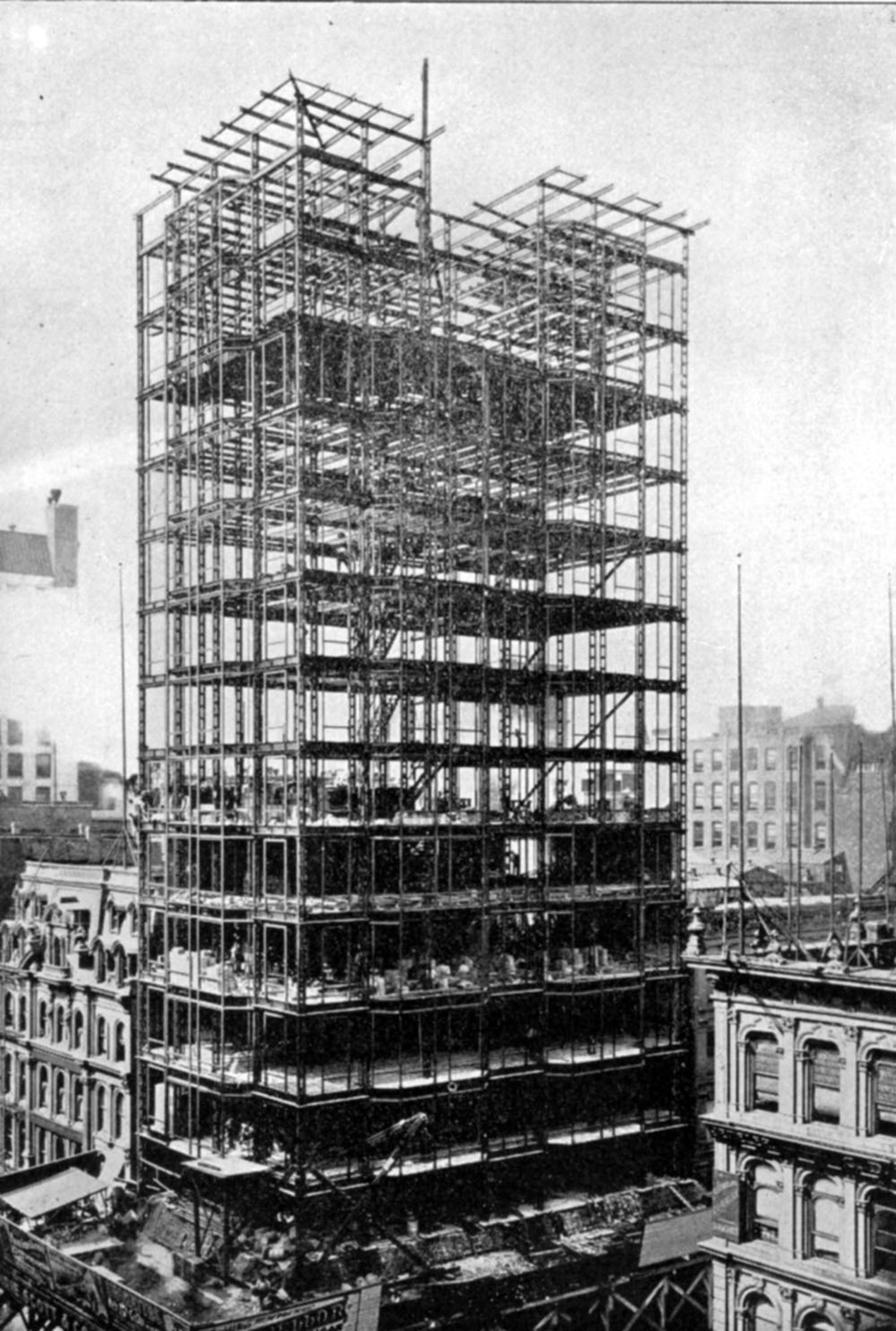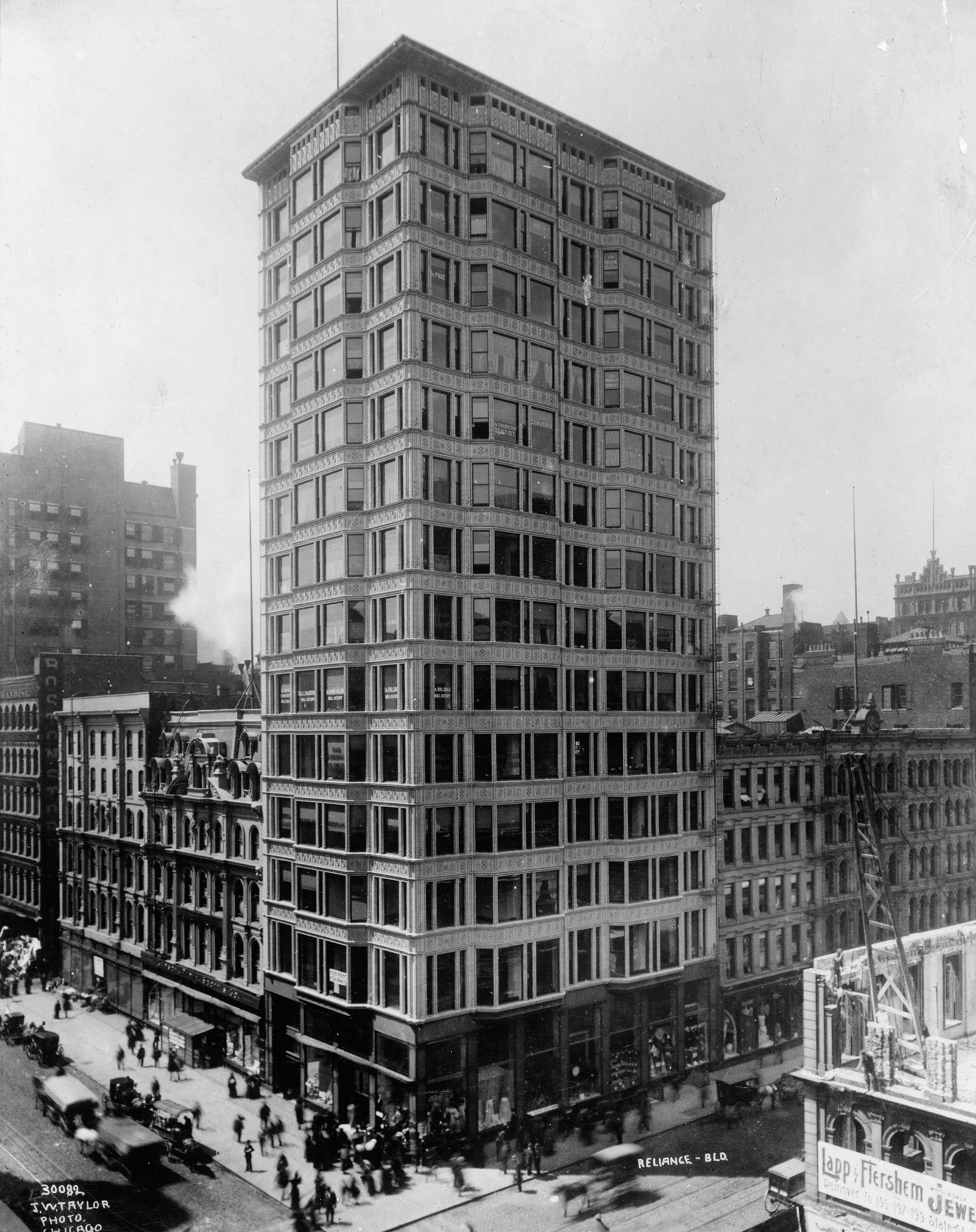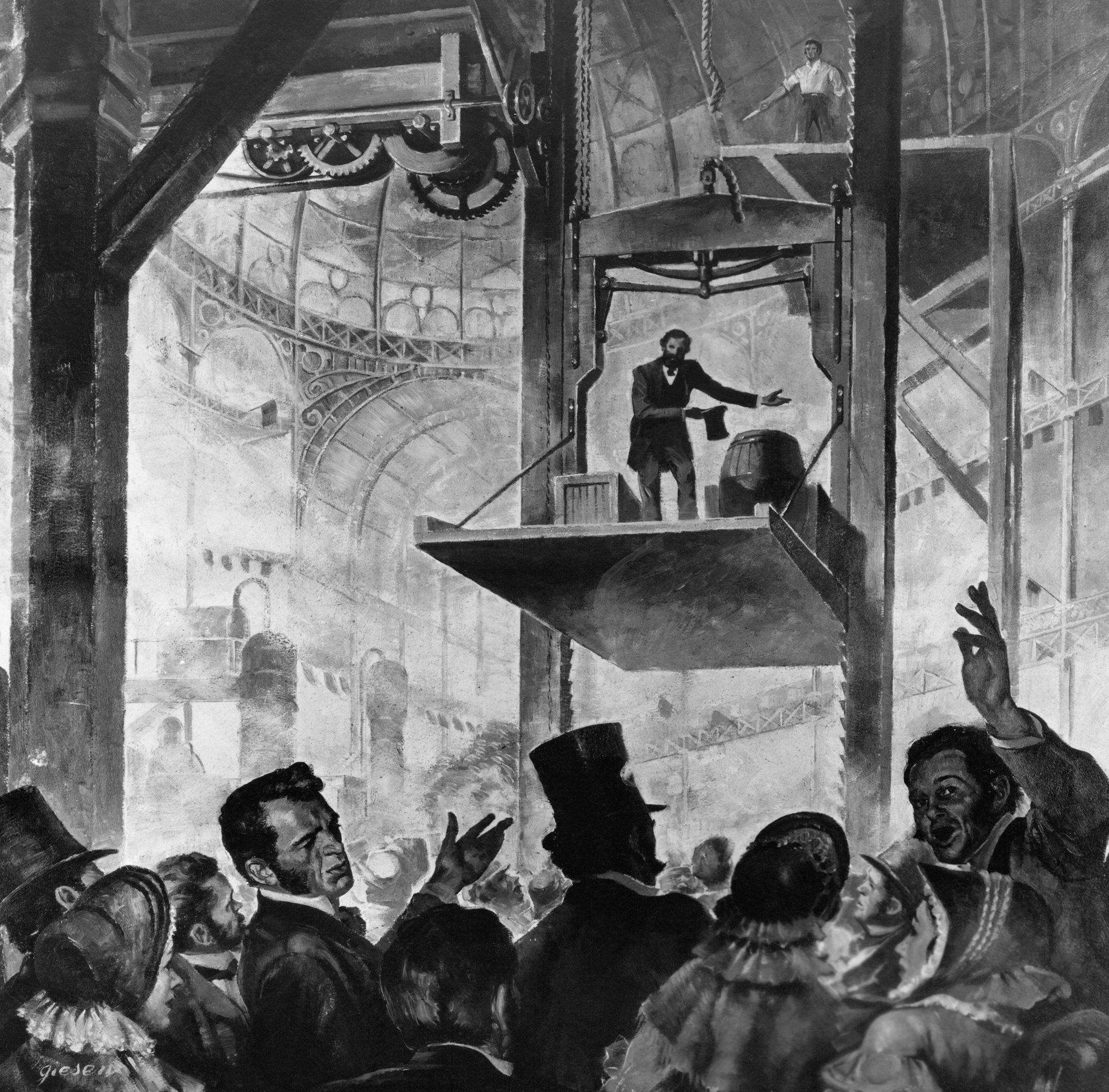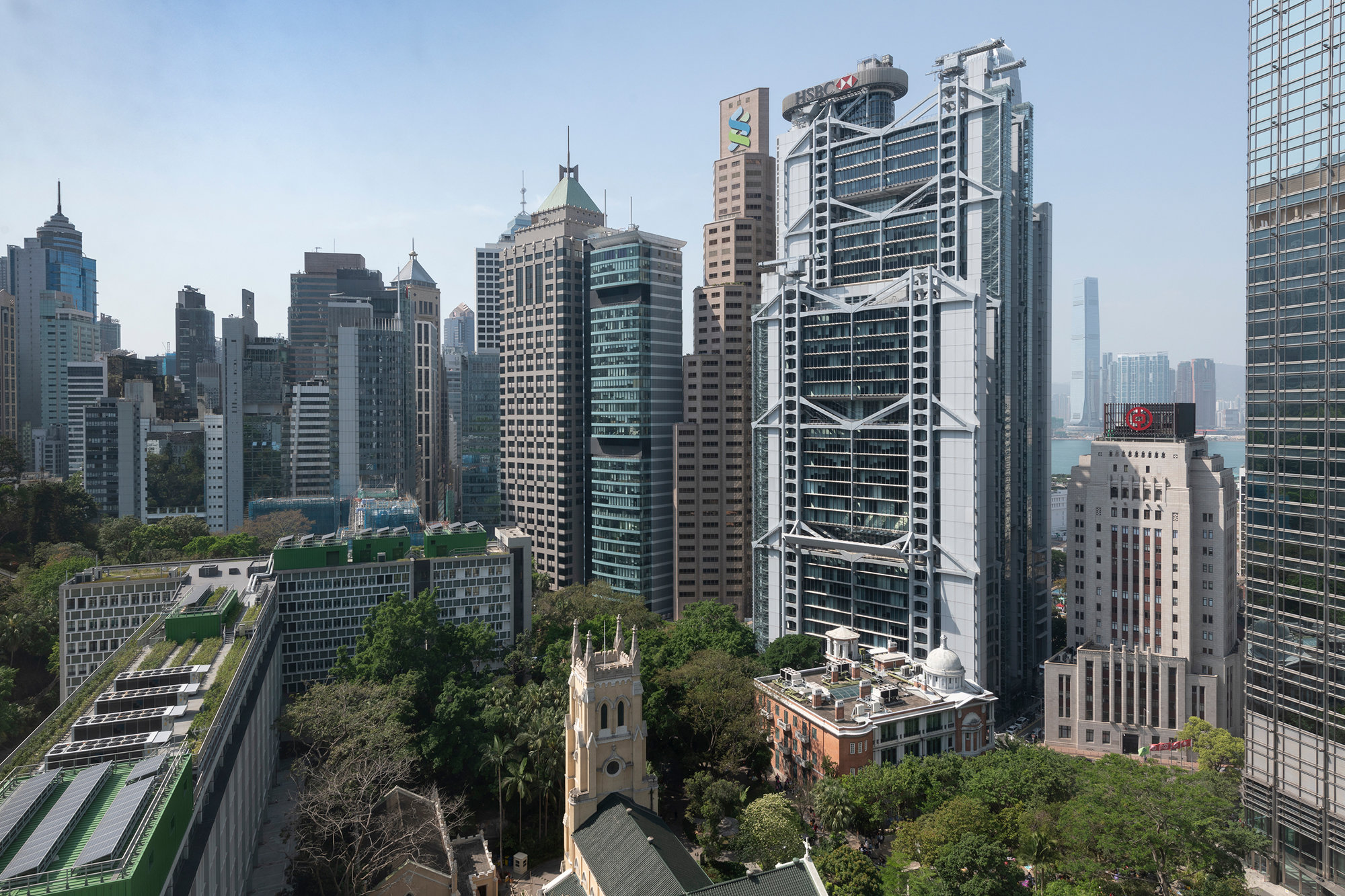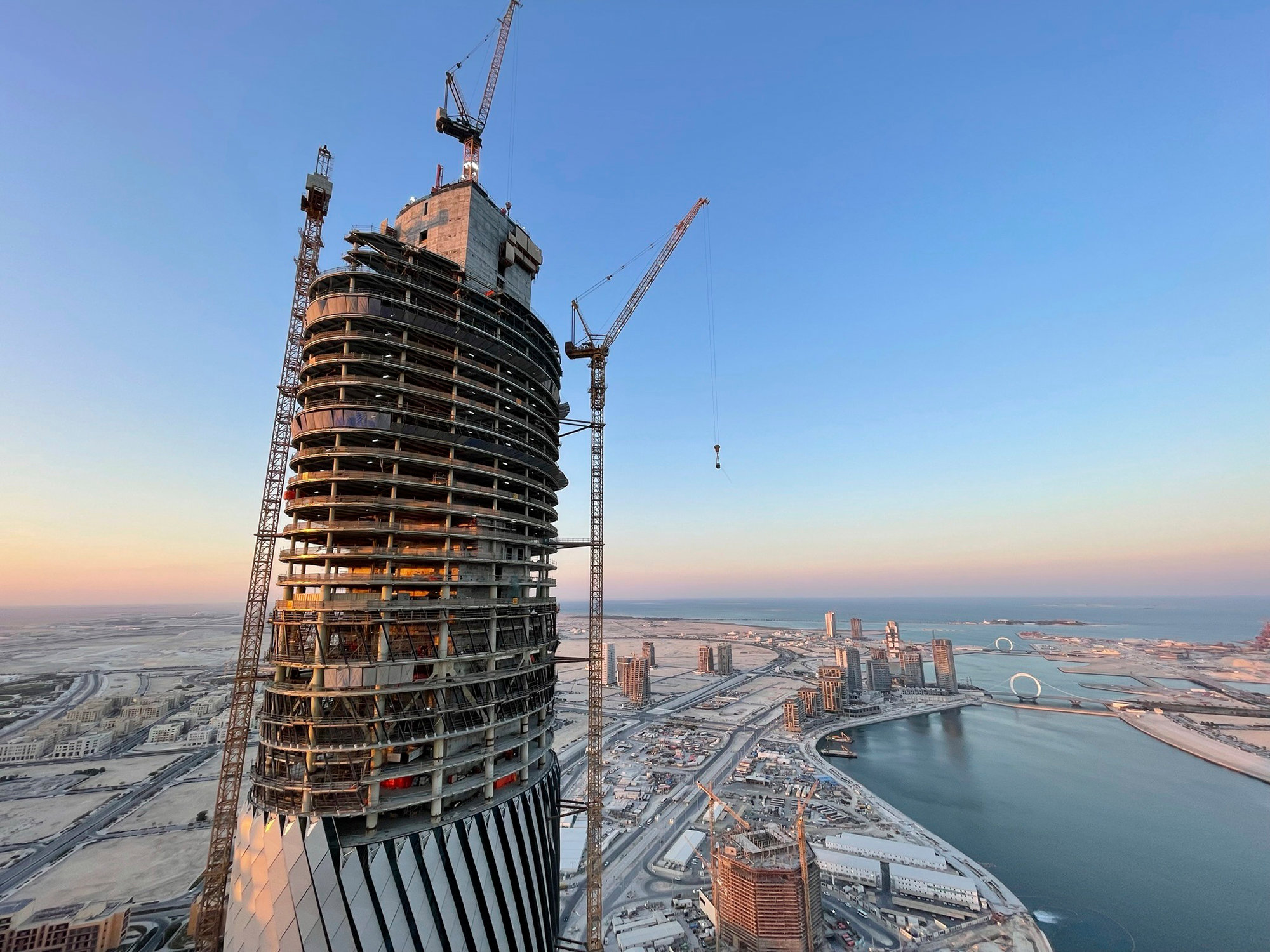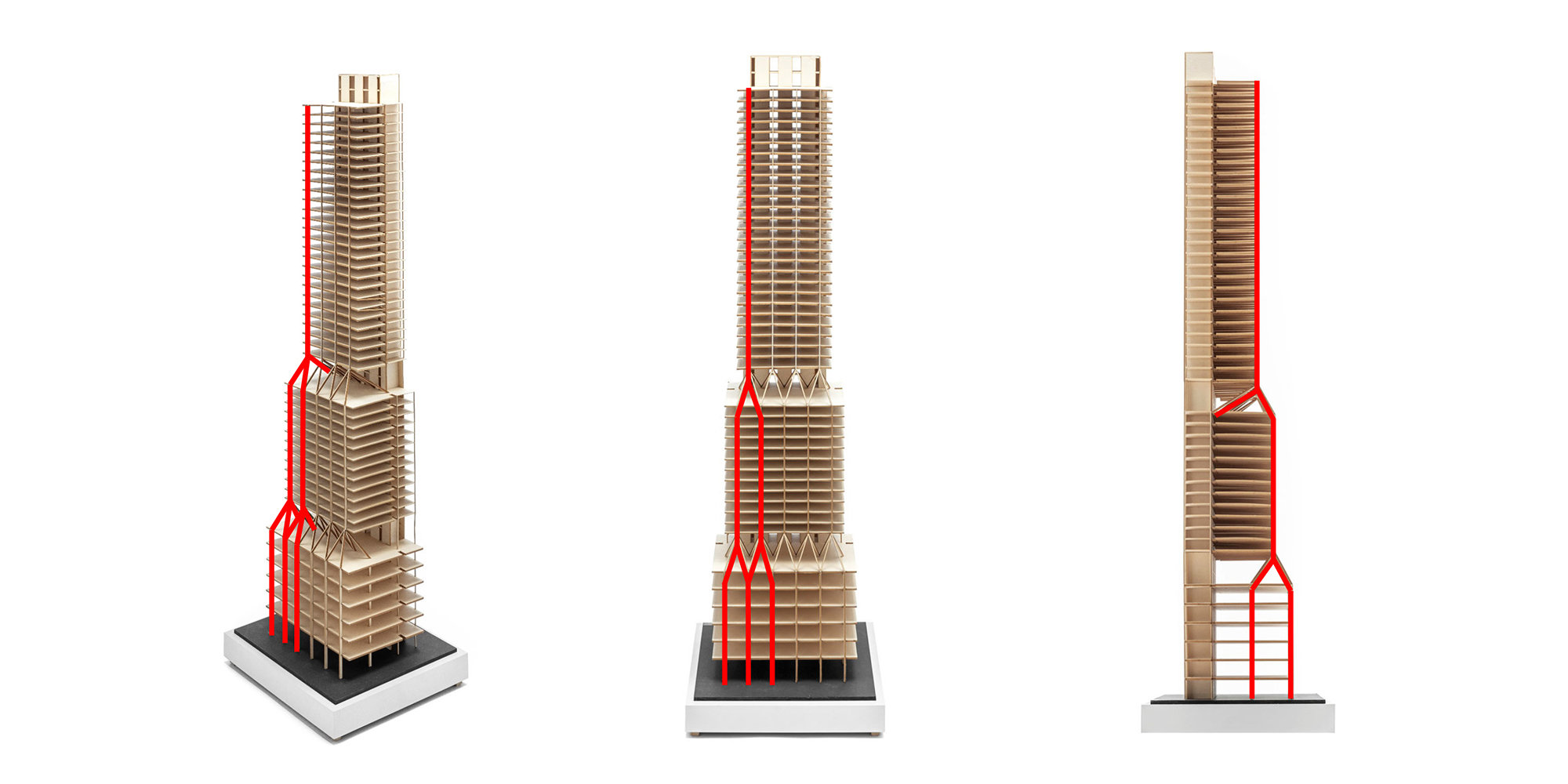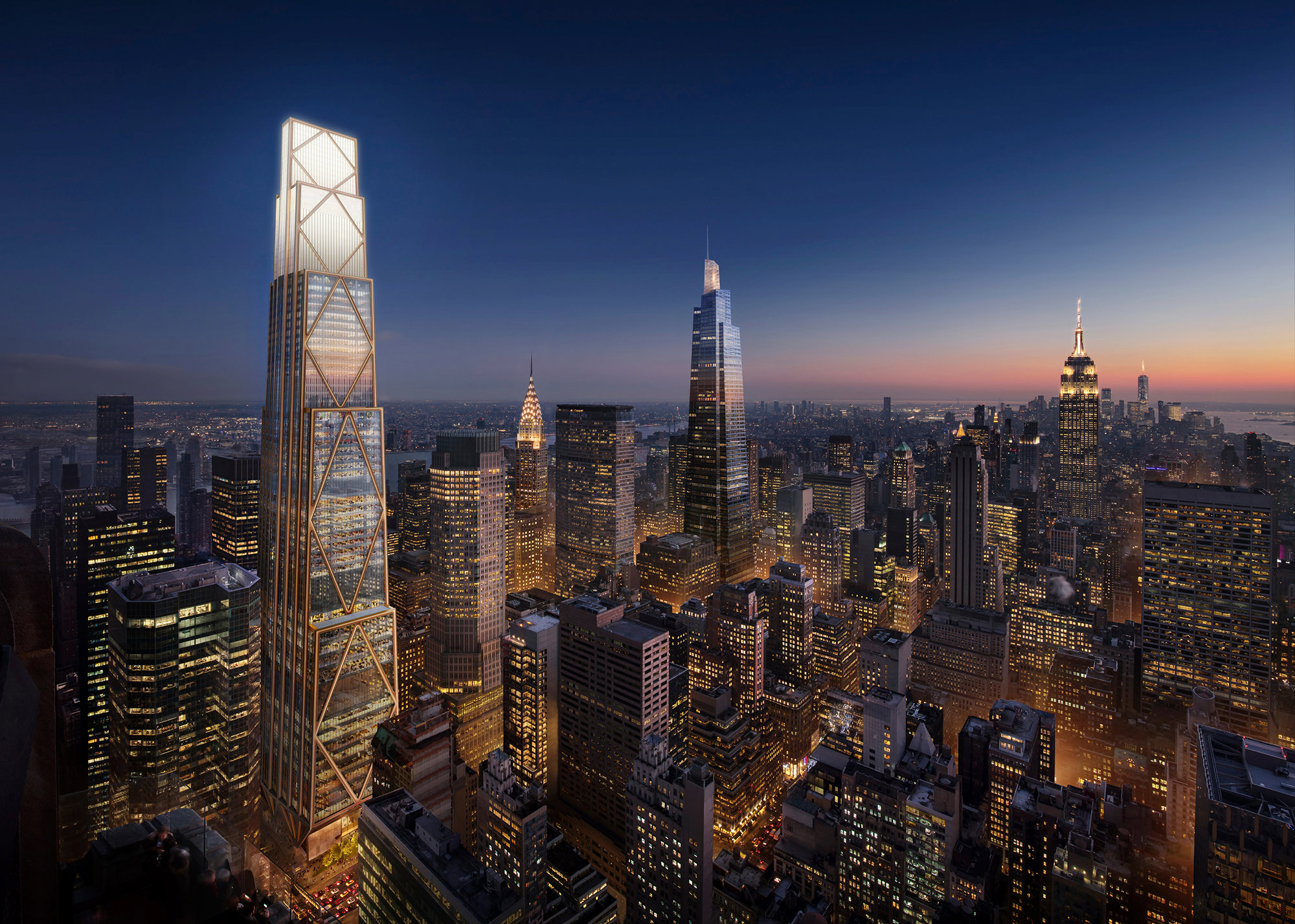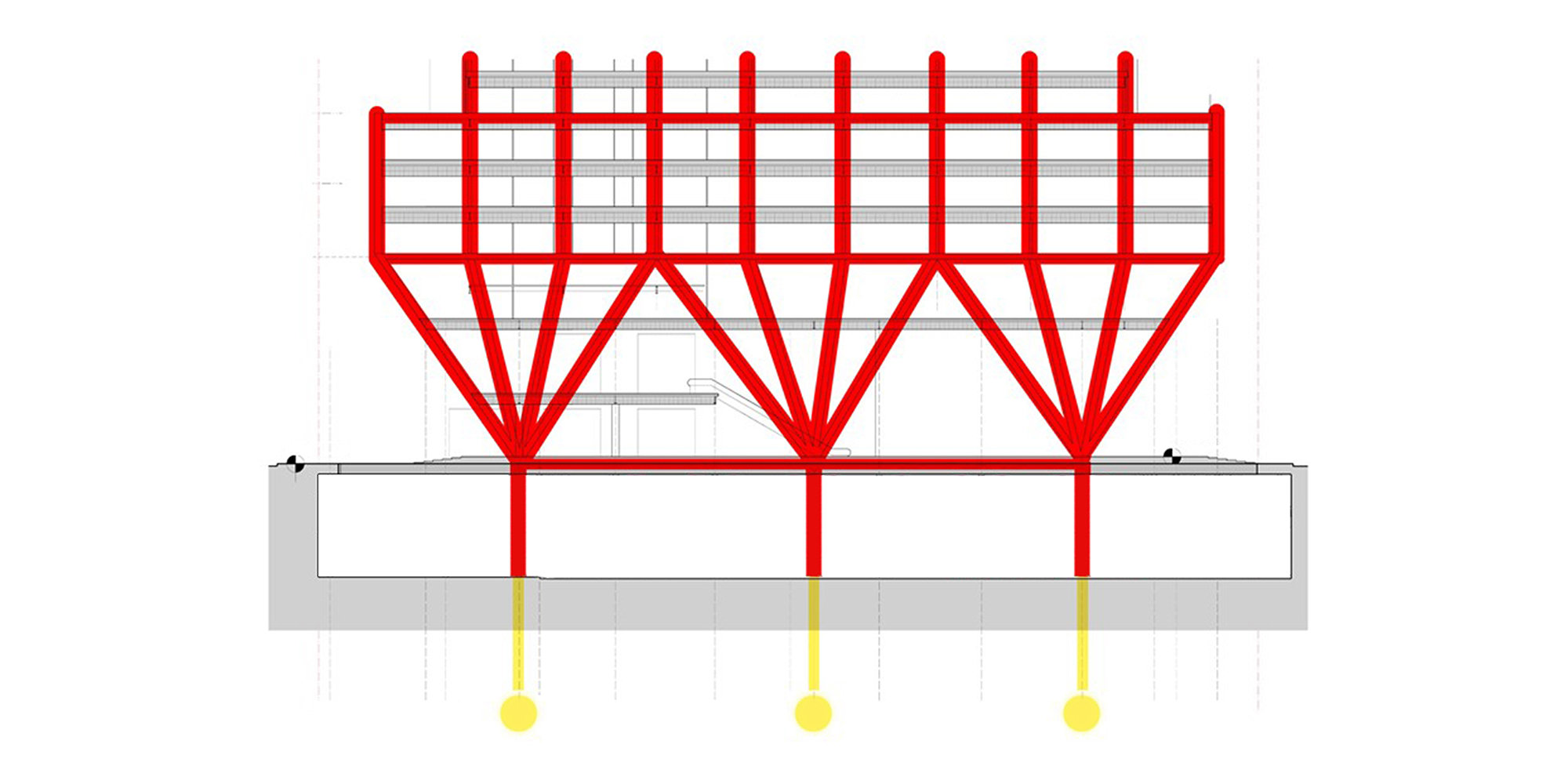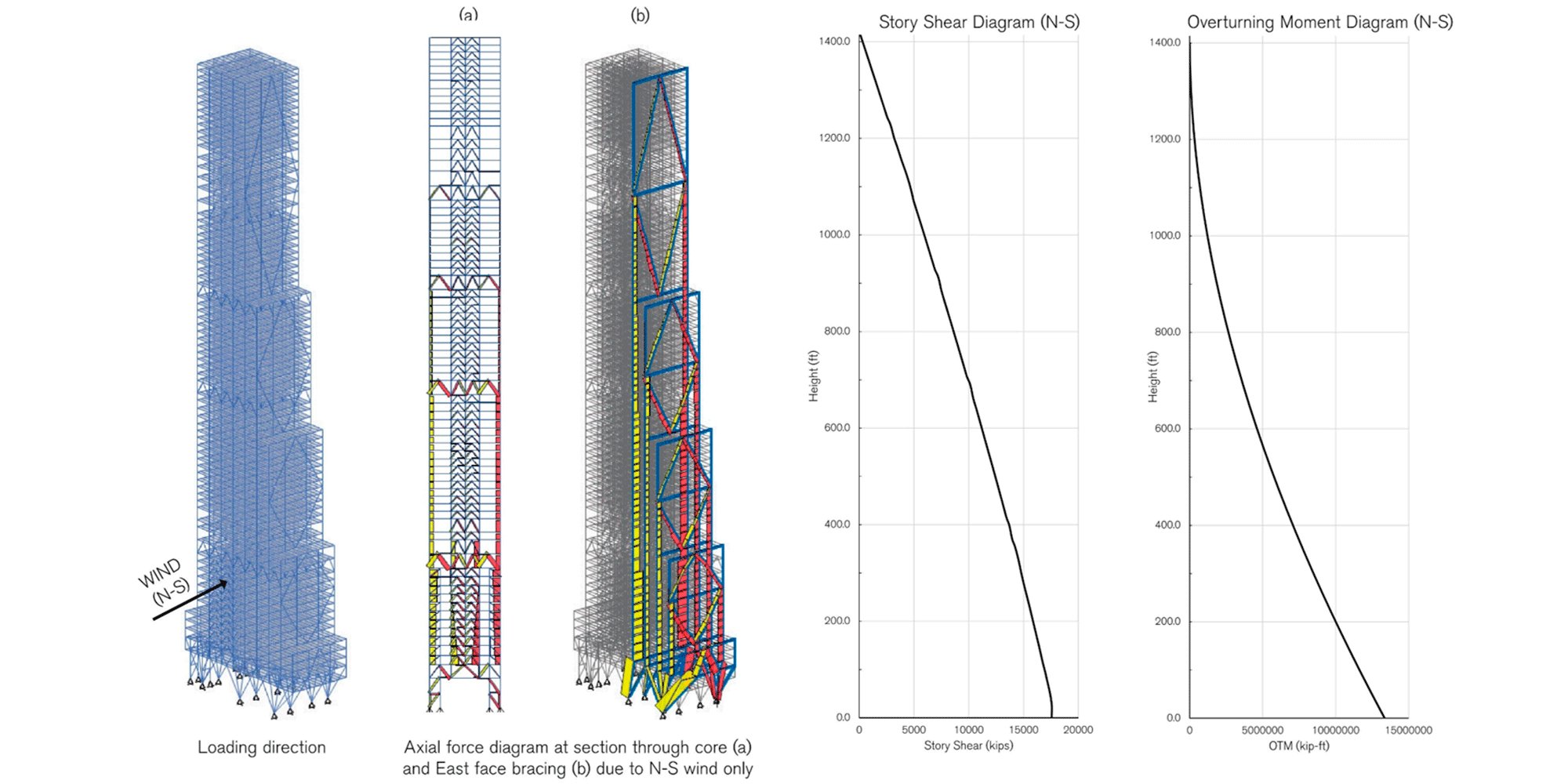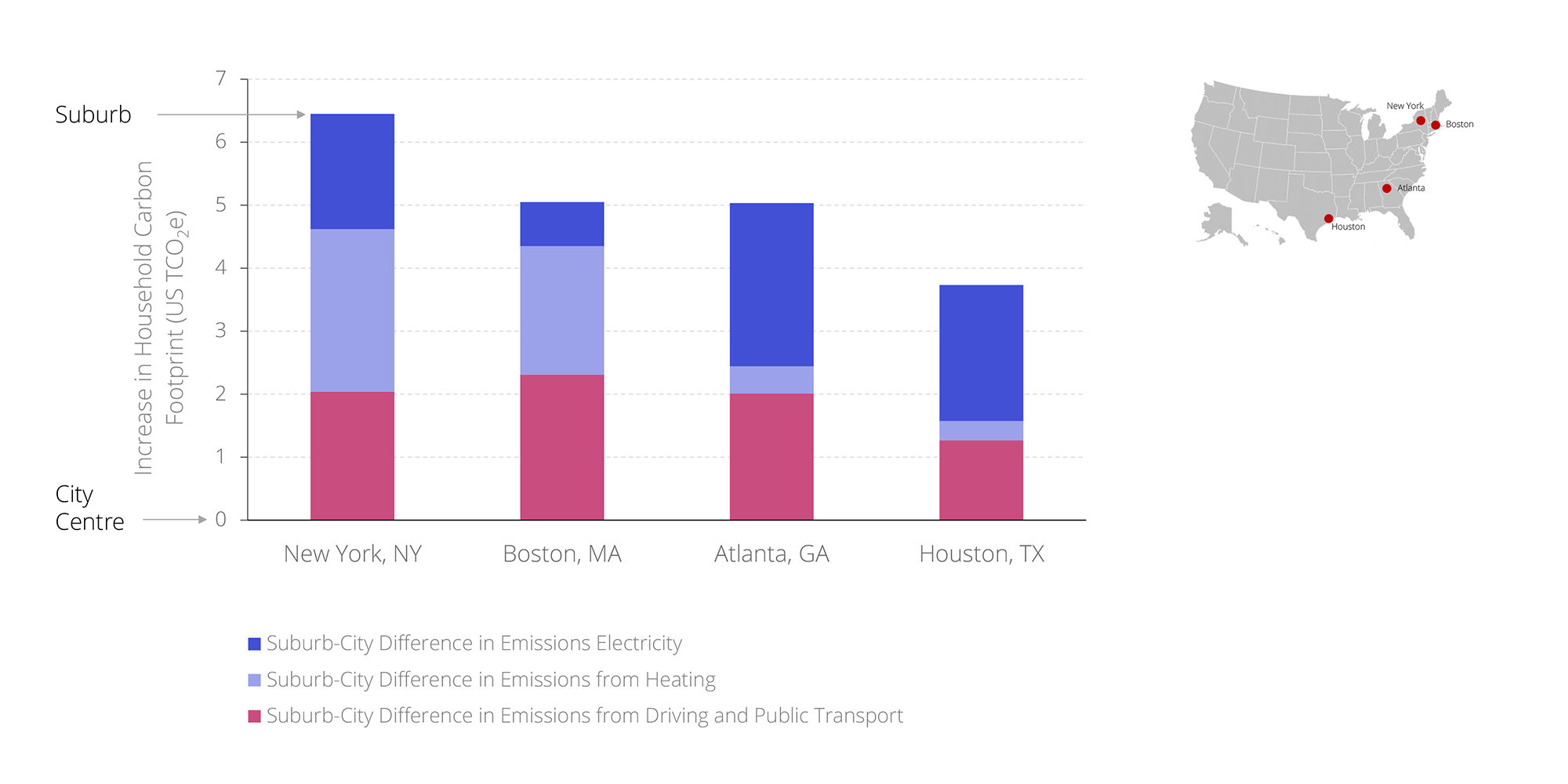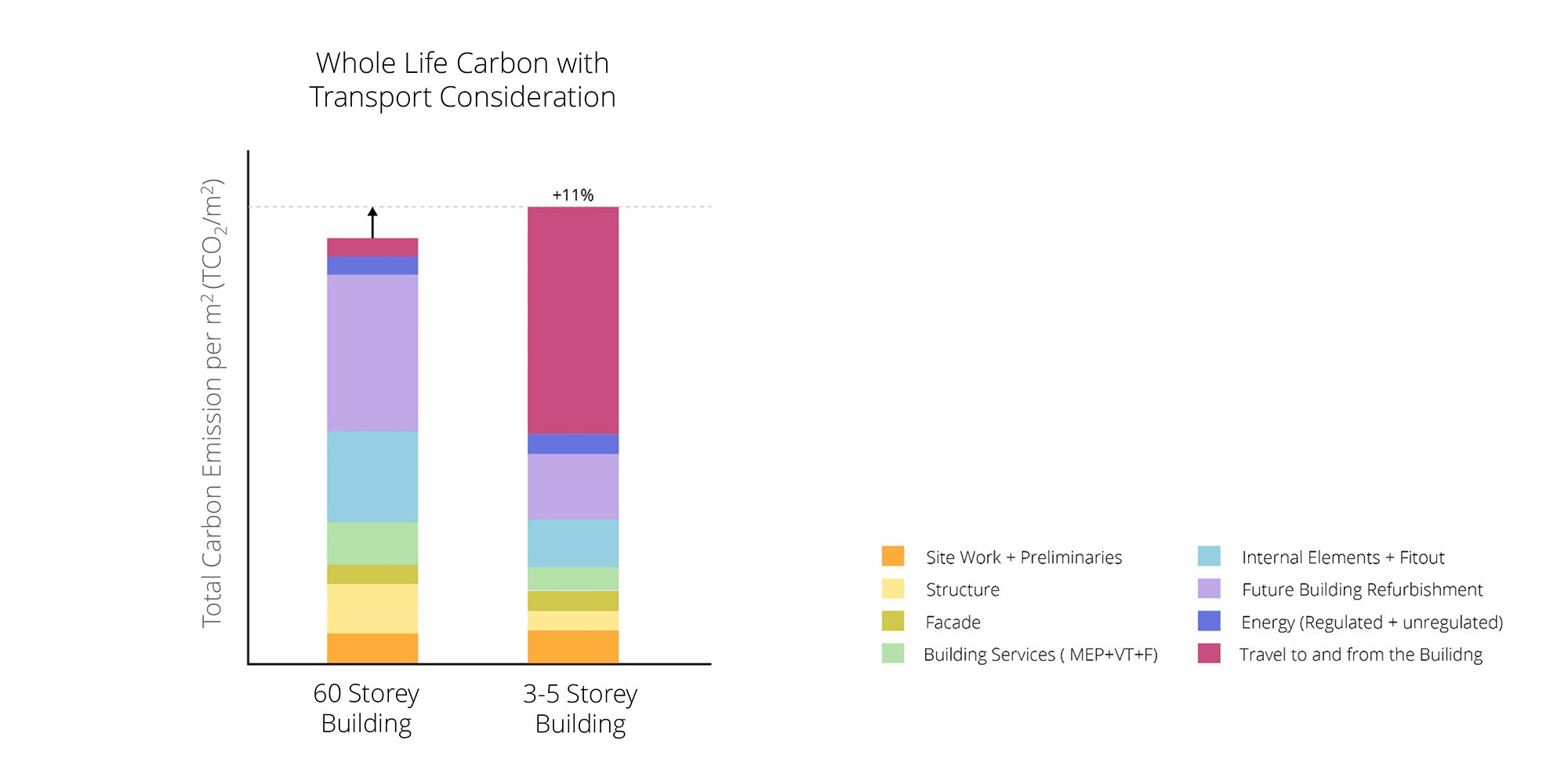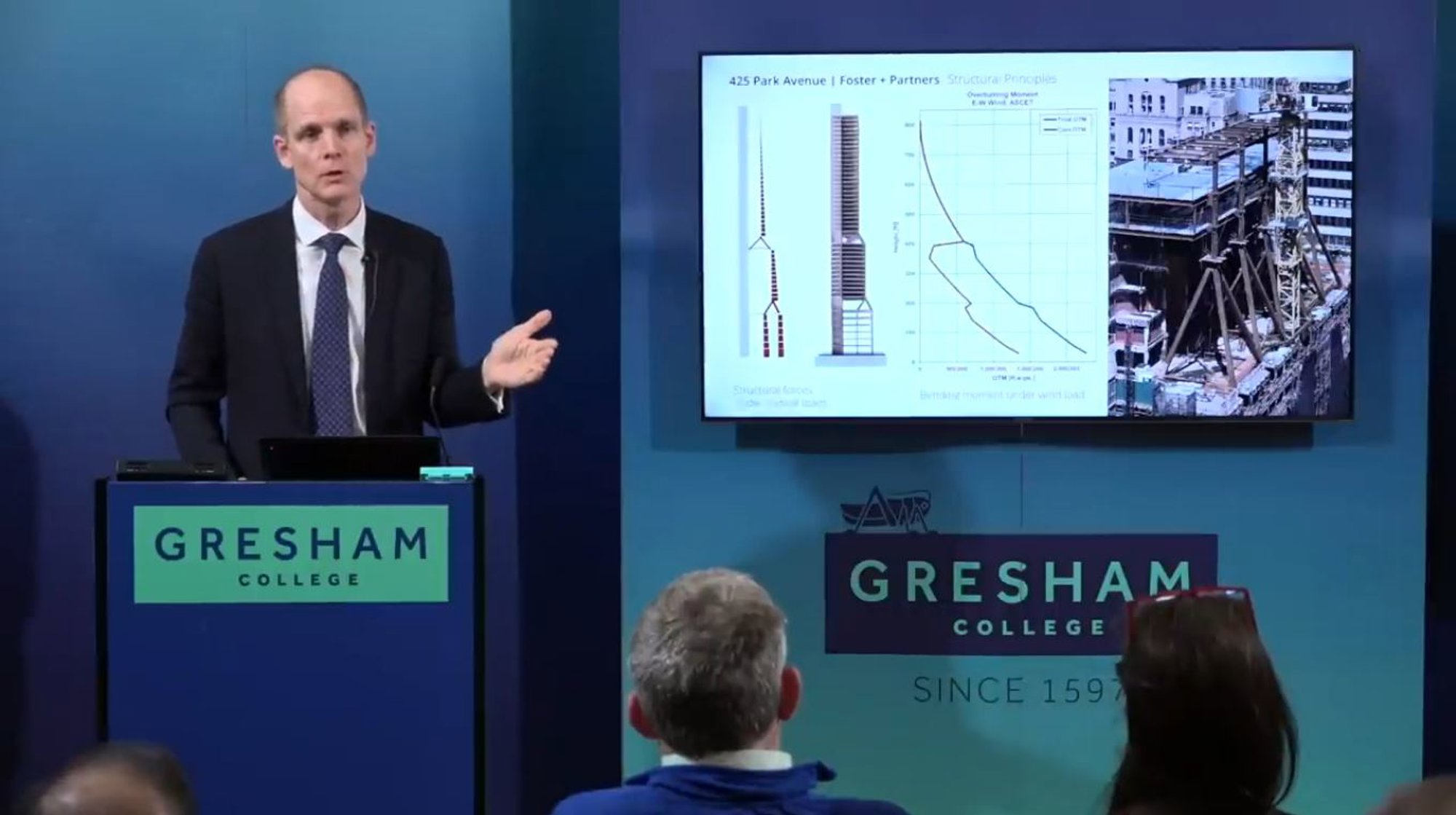Adapted from his lecture given at Gresham College in London earlier in 2023, Roger Ridsdill Smith, Head of Structural Engineering at Foster + Partners, considers the evolution of tall buildings through history and investigates how their status might be reconsidered in light of today’s climate emergency.
13th September 2023
The Future of Tall Buildings
The construction industry currently accounts for around 39 per cent of worldwide carbon dioxide emissions – 28 per cent of which is operational and 11 per cent of which is embodied in construction materials. Further, when we investigate the emissions for tall buildings, we can see that they require relatively larger amounts of carbon in their construction than low-rise structures. How do we reduce these figures? And can we justify the continued construction of tall buildings?
To address these questions, I will look back at the conditions that led to the explosion of skyscraper construction, then consider modern tall buildings using projects designed by the integrated architecture and engineering team at Foster + Partners. Finally, I will look ahead to the future of cities, and the implications of tall buildings on humanity’s carbon footprint.
A Brief History of Height
The American architecture critic Ada Louise Huxtable wrote in 1982 that ‘from the Tower of Babel onward, the fantasies of builders have been vertical.’ For as long as we have told stories, we have imagined impossibly tall structures that might, somehow, reach the heavens. However, the desire to build tall has always been limited by the structural techniques available at the time. The pyramids in Egypt were the first man-made structures to break through the 100-metre height mark. The most famous were constructed during the 26th century BC, and the largest of them, the Great Pyramid of Giza, measured 147 metres above ground level.
It is not until the period of European cathedral construction in the Middle Ages that these heights were surpassed, and even then not by much. The Lincoln Cathedral spire, built in 1311, was reputedly 160 metres high until it collapsed in 1548. Other spires followed across Europe, all around 150 metres. In 1880, Cologne Cathedral was the tallest building in the world with a 157-metre spire.
An illustration of the High Gothic Cologne Cathedral under construction and a photograph of the completed building from c.1880. Construction of the present cathedral began in the 13th century and continued for roughly 300 years, before stalling for another 300. Restoration work began in the 1820s using architectural drawings made in about 1300. All construction, including the 157-metre-tall twin towers, was completed by 1880. © INTERFOTO / Alamy Stock Photo
An illustration of the High Gothic Cologne Cathedral under construction and a photograph of the completed building from c.1880. Construction of the present cathedral began in the 13th century and continued for roughly 300 years, before stalling for another 300. Restoration work began in the 1820s using architectural drawings made in about 1300. All construction, including the 157-metre-tall twin towers, was completed by 1880. © Archive Farms Inc / Alamy Stock Photo
One of the primary reasons for these height limits is that medieval structures were built in the same way as the tall structures that came before them – with loadbearing masonry. Stone blocks or bricks were piled on top of one another to create walls. Their height was limited by the capacity of the ground beneath the wall to support its mass and the stability of the entire structure against sideways loads acting on the building, such as wind and earthquakes.
A further factor limiting the height of buildings was the difficulty of getting to the top of them. In the absence of reliable mechanical hoists, the building’s users were obliged to use stairs, which might be practical for maintenance and the occasional visit, but unrealistic for use by large numbers of people.
Illustrations from Eugène Viollet-le-Duc’s Dictionnaire raisonné de l’architecture française du Xie au XVIe siècle (1858). The constructive (left) and longitudinal (centre) section drawings show the Château du Haut-Koenigsbourg in Alsace, France. The structure dates from the Fifteenth Century but follows medieval Gothic construction techniques from the Thirteenth Century. On the right are two detail wall-construction drawings, illustrating Roman rubble and brick methods (above) and medieval walls (below) with ashlar stone facing at the main points of support.
The completion of Cologne Cathedral in 1880 – to a centuries-old medieval design – was one of the last examples of tall structures built with loadbearing masonry. Meanwhile, across the Atlantic, the first true ‘skyscraper’ would soon begin its construction. Separated in time by just a few years, the two buildings would be eons apart in their structural design.
Entering the High-Rise Era
The Home Insurance Building in Chicago, completed in 1885, was designed by American architect William Le Baron Jenney. It is considered to be the world’s first skyscraper due to the incorporation of structural steel in the loadbearing walls. Originally ten stories and 42 metres (138 feet) high, it may be small compared to the towers of today but the Home Insurance Building is recognisable as a modern tall building, something that would not become possible until the innovations of the Industrial Revolution at the end of the 19th Century. This was a period that produced major advances in construction materials and their transportation, as well as developments in structural, electrical and environmental engineering.
The Home Insurance Building, Chicago, following its completion in 1885 and during its demolition in 1931. Designed by American architect William Le Baron Jenney, the building is considered the world’s first skyscraper due to the incorporation of structural steel in the walls.
While Le Baron Jenney’s Home Insurance Building is often seen as the first skyscraper, buildings such as the Reliance Building, 1895, were more unequivocal in their use of a steel skeleton. Shown here under construction and completed, the steel-framed Reliance Building was primarily designed by American architect Charles B. Atwood. The façade is composed of plate-glass bay windows surrounded by terracotta cladding. © Tango Images / Alamy Stock Photo
While Le Baron Jenney’s Home Insurance Building is often seen as the first skyscraper, buildings such as the Reliance Building, 1895, were more unequivocal in their use of a steel skeleton. Shown here under construction and completed, the steel-framed Reliance Building was primarily designed by American architect Charles B. Atwood. The façade is composed of plate-glass bay windows surrounded by terracotta cladding. © Tango Images / Alamy Stock Photo
Two technical advances, in particular, overcame the medieval limitations of the tall building. In 1854, Elisha Graves Otis demonstrated a new safety hoist in New York City. Cutting the single rope supporting the hoist that he was standing on, the platform dropped a few centimetres and then stopped, a result of the spring attached to the top of the platform that engaged notches into the guide rails. Popular history records this incident as the beginning of elevators, but the reality is more prosaic. By this time, there were already many rival inventors and companies thinking of ways to raise people through buildings. This activity was a response to the growing societal need where rising land values driven by the economic benefits due to urban density justified higher building costs.
The second major innovation was the incorporation of structural steel into the load-bearing structure of buildings. In Britain, inventor Henry Bessemer developed a manufacturing process in 1855 which dropped the price of mild steel by a factor of six, enabling it to be produced more cheaply than wrought iron.
A Bessemer converter at the American manufacturer Lackawanna Steel in New York, 1903. The primary process involved blowing air through molten pig iron, which results in oxidation, removing impurities. Bessemer’s process took between 10 and 20 minutes to convert three to five tons of iron into steel, replacing what would previously have been a full day of heating, stirring and reheating.
This was the beginning of the modern era of steel production; instead of buildings using loadbearing masonry walls, they started to be constructed as a steel skeleton surrounded by lighter-weight walls. Buildings were no longer limited by the ability of large numbers of people to walk up them. And their lighter construction reduced the loads in the walls and in the foundations beneath them.
Of course, the Home Insurance Building in Chicago, a product of the capitalist society of the US in the late 1800s, needed an economic reason to drive its construction in addition to the technological ability to build it. High-rise construction was developing most rapidly in Chicago, and then in New York, where population levels were growing extraordinarily fast and land values were increasing. New York property values doubled between 1840 and 1870, meaning that owners had to maximise their space within more constrained plots. And there was an economic benefit to staying close to the coast and to one another; in 1816, it cost as much to transport goods 30 miles inland as it did for those goods to cross the Atlantic.
This combination of technology, economics, and political will drove the extraordinary expansion of high-rise construction in the nineteenth century.
The Technology of Tall Buildings at Foster + Partners
Foster + Partners have a long history of tall building construction, starting with the Hongkong and Shanghai Bank Headquarters in Hong Kong in 1986. Other buildings by the studio followed: including Century Tower in Tokyo, Commerzbank Tower in Frankfurt and 30 St Mary Axe in London. Today, Foster + Partners continue to design innovative, high-rise structures working as integrated teams of architects and engineers to provide solutions that are logical, efficient, and elegant.
The north facade of the Hongkong and Shanghai Bank Headquarters in Hong Kong (1986). The Hongkong Bank was the first tower to challenge the central core concept that had persisted since the birth of the high-rise office building in the 1880s. By creating a suspension structure outside of the floor plates and redistributing the elevators, staircases, and bathrooms to the two narrow edges of the plan, it was possible to create uninterrupted, loft-like spaces throughout the building. © Nigel Young / Foster + Partners
A tower is a cantilever, fixed at the base, and subjected to both vertical and lateral loads over its height. The applied ‘live’ loads are divided into the vertical loads due primarily to the building users, and the lateral loads that are due mainly to wind and earthquakes. The building also must support the ‘dead’ loads, that is the self-weight of the structure, the cladding, the finishes, and the services. These loads are carried by the structure down to the foundations. The following case studies of high-rise projects designed by the integrated team at Foster + Partners show the structural principles employed.
Lusail Towers: The most common way to resist the lateral loads in modern buildings is by using the building’s core, the part of the building that contains the vertical circulation – the stairs and lifts required to provide access, as well as possibly the spaces needed to house the services. Above a certain height, anywhere from 150 to 250 metres depending on the building and the applied loads, the core gradually ceases to be the most efficient method of providing lateral stability on its own.
A visualisation of the Lusail Towers project in Qatar, envisioned as the catalyst for a new central business district in Lusail city with a distinctive collection of four high-rise buildings. The 1.1 million-square-metre development will host the headquarters for the Qatar National Bank, Qatar Central Bank and Qatar Investment Authority alongside several other global organisations including Qatari Diar, while creating a new downtown district that is sensitive to the climate. © Foster + Partners
This was the case for the Lusail Towers in Doha, designed by the practice as part of the FIFA World Cup 2022 celebrations in Qatar. The project consists of four towers – a pair that are 214 metres tall and a pair that are 300 metres. For the taller pair of towers, the engineering team mobilised the perimeter structure to provide greater strength and stiffness. This is achieved with outrigger trusses that link the core to the perimeter columns at two points over the building height.
Cardboard model and structural section drawing of one of the Lusail Towers. These models are created by the in-house structural team at Foster + Partners to show only the structure of a project, with the façade removed, exposing the skeleton. © Foster + Partners
425 Park Avenue: In some instances, it is beneficial to the building plan to move the core to the edge of the building. An example of this is the recently completed tower at 425 Park Avenue, the result of a competition that Foster + Partners won in 2012.
425 Park Avenue is the first full-block office building on New York’s Park Avenue in over 50 years. The 47-story tower includes a triple-height lobby, world-class office accommodation, external green spaces, an expansive social amenity level and a 38-foot-tall penthouse floor. Built to LEED Gold standard, the building has earned Well Core certification at Gold level, in recognition of its features which enhance the health and wellbeing of occupants. © Nigel Young / Foster + Partners
This project had two main structural drivers. Firstly, tall buildings in Manhattan are legally required to fit within a tapering volume, which becomes thinner over the building height to allow more light to penetrate down to street level. Secondly, the client wished to move the vertical circulation to the rear of the building, away from the Park Avenue entrance, to create whole floorplates with views of the streetscape and Central Park.
The resulting structure was conceived to be as minimal a response as possible to resist the vertical and lateral loads acting on the tower and where architecture and structure are completely aligned. The facade could be removed entirely and the skeleton revealed would be completely consistent with the way the building appears from the outside.
The card model of 425 Park Avenue demonstrates the tower’s structural principles. A single line of columns starts at the top of the building and bifurcates at two levels as it descends. Each bifurcation creates diagonals that also connect to the core so that the columns and the core act together to provide stiffness and strength in both orientations. © Foster + Partners
China Merchants Bank: At 388 metres tall, the China Merchants Bank tower will be the tallest building to date in Shenzhen. The stability for the building is provided by a combination of a reinforced concrete core coupled with the external columns around the perimeter of the tower. The area is subject to seismic activity and the energy transferred into the building by the ground movements is dissipated by ‘buckling restrained braces’ – a new technology that forms part of the outrigger trusses linking the cores to the perimeter frame.
Visualisations of China Merchants Bank Headquarters in Shenzhen. The project comprises a tower as the key component of a vibrant mixed-use development that creates a new city quarter. The tower achieves three stars in the Chinese ‘Assessment Standard for Green Building’ - the highest rating available. © Foster + Partners
Visualisations of China Merchants Bank Headquarters in Shenzhen. The project comprises a tower as the key component of a vibrant mixed-use development that creates a new city quarter. The tower achieves three stars in the Chinese ‘Assessment Standard for Green Building’ - the highest rating available. © Foster + Partners
270 Park Avenue: In 2017, Foster + Partners entered a competition for the new headquarters of JP Morgan at 270 Park Avenue. The brief called for a building around 420 metres tall, on a narrow site just 43 metres wide and, crucially, over underground railway lines that lead into Grand Central Station.
During the competition, the teams were informed that they would all be obliged to adopt a specified structural arrangement with multiple columns leading down into the basement to avoid the trains underneath. But the Foster team created another approach, gathering the columns into fan structures and bringing the loads down from each facade at just three points. Inside the building, the loads come down on double columns at a further three points.
Structural section through the ground level of 270 Park Avenue, showing the distinctive fan columns.
Analysis diagrams from the JP Morgan competition showing the behaviour of the structure under wind loads on the north or south façade. The central pair of diagrams show two views of the forces in the structural members – the wind load is resisted by a combination of the central cores linked to the outer columns by outriggers, visible in the left hand diagram, and the cross bracing on the east and west facades, visible in the right hand diagram. The graphs to the right show the horizontal shear force and overturning moment acting on the structure due to the wind loads, both increasing towards the base of the building.
The structural solution is driven by the constraints of the site. The external bracing on the east and west facade provides stiffness and strength to the building over and above that provided by the core and outriggers. The building doubles the density of the previous building on the site and 97 per cent of the building materials from the original building were recycled, reused or upcycled.
Density Debate: Carbon analysis of tall buildings
Despite the advances in efficient high-rise design and construction, tall buildings are still synonymous with high consumption. The question remains: are tall buildings a feature of a sustainable, carbon- and material-aware future? Or should they be consigned to the past?
Research into this area has been developing recently, and urban economists in particular have led the way. Harvard professor Edward L. Glaeser has published extensively on the subject and his work directs us to an initial answer. He writes: ‘Low-density suburbs will leave a significantly deeper carbon footprint, it turns out, than Americans who live cheek by jowl in urban towers … When environmentalists resist new construction in their dense but environmentally friendly cities, they inadvertently ensure that it will take place somewhere else – somewhere with higher carbon emissions.’
Compared with suburban and rural areas, residents in urban environments have lower annual carbon emissions – a key metric for measuring environmental impact. What’s more, the tall buildings can more densely accommodate a growing global population, two thirds of which will be living in urban zones by 2050.
Two carbon footprint metrics are useful here: the whole-life carbon of a building, and the household carbon footprint of the building users. The whole-life carbon footprint accounts for the carbon produced during construction (embodied carbon) and the carbon produced during its use (operational carbon). Improvements in the insulation and power requirements of modern buildings have resulted in a substantial drop in their operational carbon footprint and, as a result, the embodied carbon of a construction has become relatively more important. The second metric is the household carbon footprint, which measures the greenhouse gas emissions of the individuals within a household, including their requirements for energy, transportation, food, goods and services.
Tall buildings can more densely accommodate a growing global population, two thirds of which will be living in cities by 2050.
The diagram below shows an estimate of the household carbon footprints of residents across 31,500 zip codes in the United States by Christopher Jones and Daniel Kammen of the University of California, Berkeley. There is a recognisable pattern. The densest areas, the city centres, show the lowest household carbon footprints, represented in green. The suburbs show the highest, seen in red. The primary reason for the difference between suburb and city centre is the reduction in private transport. Transportation’s carbon footprint is about 50 per cent higher in large suburbs compared to large principal cities, while total household carbon footprints are about 25 per cent higher.
Map of household carbon footprints across zip codes in the eastern United States. ‘Spatial Distribution of U.S. Household Carbon Footprints Reveals Suburbanization Undermines Greenhouse Gas Benefits of Urban Population Density’, Christopher Jones and Daniel M. Kammen, Environmental Science & Technology 2014 48 (2), 895-902
Other studies are consistent with these results. Professor Glaeser examined metropolitan areas across the United States to compare the difference in the household carbon footprints between the suburb and city centre for each area. In the graph below, each bar represents the increase in household carbon footprint between the city centre and its corresponding suburb. Households in northern cities (New York, Boston) use more natural gas for heating (shown in light blue), while households in southern cities (Atlanta, Houston) use more electricity for cooling (shown in dark blue). And the carbon due to transport (in magenta) is consistently higher in the suburbs compared with the city centres.
The same question was addressed by Colin Beattie and Peter Newman in Sydney, Australia, where the carbon footprint of 4,000 living spaces – a mix of high-rise, mid-rise, low-rise and individual houses – was compared. Once again, the study found that the higher emissions due to private transport (in magenta) in detached houses in low density areas was the defining factor that led to these areas having the largest carbon footprint.
But what happens when we include the embodied carbon of construction into the calculation? Are the environmental benefits of dense city living cancelled out by the additional carbon emissions of construction of tall buildings?
This is an emerging field, but comparisons have been carried out by the Foster + Partners Sustainability Group and published by the World Green Building Council. These compared the whole-life carbon of a tall building (sixty storeys) in a dense city with strong public transport connections to a low-rise development (three-to-five storeys) in a suburban location accessed almost exclusively through private vehicle transport. The results also anticipate the future electrification of transport, as well as the reduced carbon content of the materials due to projected reductions in fossil fuel use.
Graph illustrating differences in whole-life carbon emissions between a sixty-storey building and three-to-five-storey building. ‘Transitioning to an integrated whole life approach to sustainability in the built environment,’ Chris Trott, World Green Building Council and Foster + Partners, 2021
The results show that even though the embodied carbon of the structure (shown in yellow) is greater for the high-rise than for the low-rise, the carbon footprint of private transport (in magenta) for the less-dense development outweighs the embodied carbon savings from low-rise construction.
Economically speaking, the density that tall buildings unlock in our cities enables public transport to become viable, and local travel distances become shorter, permitting more walking and cycling. Additionally, there is an operational decrease in carbon emissions from shared heating and cooling in densely populated structures. As a result, and as the research set out above has shown, despite the higher embodied carbon cost, the total carbon footprint of a tower in a dense city centre is still lower than a low-rise low density suburban development.
The Future
This brief dive into the history of tall buildings and their structural development – up to some of Foster + Partners’ most advanced and contemporary high-rise designs – has shown a consistent march towards structural lightness and efficiency. It was the shedding of weight, from loadbearing wall structures to frame systems, that enabled us to climb past millennia-old height constraints.
We need to continue to design and build lean buildings, not only to reflect the forces acting on them and the constraints of their locations, but also to reflect a design philosophy that considers resource scarcity. Any departure from efficient design needs to be justifiable through the benefits to those who use the building or its vicinity.
Broadening our understanding of historical structures, we also know that, wherever possible, we should consider reusing existing buildings to avoid incurring the embodied carbon of new construction. When this is not practical, we should recycle the materials from the buildings that we remove.
And we need to make buildings that last. A city street can last for 500 or 1,000 years, while a building might be pulled down after twenty. Our philosophy needs to change; we need to think of buildings as vertical streets adding useful density to our cities, whose functions can change, but whose structure remains.
We need to build efficiently, reuse and recycle wherever possible, and minimise carbon in building construction and use.
Tall buildings came about through a combination of technological innovation and societal need. A tipping point occurred around the second half of the nineteenth century, and a period of rapid growth followed. We are at a tipping point now with regards to our climate. We need to build efficiently, reuse and recycle wherever possible, and minimise carbon in building construction and use. But we cannot consider buildings in isolation from their urban context. Increased density results in lower overall carbon emissions and creates places for people to commune and to thrive.
Author
Roger Ridsdill Smith
Author Bio
Roger Ridsdill Smith is Head of Structural Engineering at Foster + Partners. After graduating from the University of Cambridge, he began his professional career in Paris. In 1994, he joined Ove Arup and Partners in London, becoming a director of the firm in 2003. Roger then joined Foster + Partners in 2011 to start the Structural Engineering team. Since their inception the team have worked on the design and delivery of tall buildings in Asia, the Middle East, Europe and the United States.
Editors
Tom Wright and Clare St George










